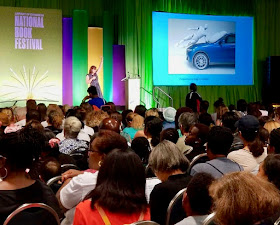 |
| illus. by TeMika Grooms; Peachtree Publishing |
“…it took many years, and thousands of crash tests, to create the safe vehicle you ride around in,” writes Jen Swanson. Thousands of safety designers and other engineers – aided by anthropomorphic test devices (aka: the crash-test dummies) – had to define safety problems, imagine solutions, carry out the tests, and collect data so they could design safer cars.
In Save the Crash-Test Dummies, Swanson highlights the engineering that goes into car design, and introduces readers to the family of crash-test dummies, which has grown to now include the dad, mom, three kids sized to represent children aged ten, six, and three. And yes, they have a crash-test dog!
There are plenty of diagrams, a chapter on engineering self-driving cars, and an overview of the diversity of problems different types of engineers solve.
But enough about the book – let’s meet the author!
GROG: So Jen, is it easier now to entice editors with engineering topics? What is your approach in pitching such topics to editors? Has it changed now that you are better known for this genre?
Jen: Editors are more open to STEM topics than ever before. This is so exciting—especially for topics that focus on technology, engineering, and math. The pitch for an engineering-heavy book is really the same as any other: you need a really good HOOK. When I first started working on this book, I wanted to write about the self-driving car. But I needed something to make this topic stand out. It came to me one night while on a walk with my husband. Crash-test dummies! The perfect way to make the history of car safety engineering exciting and intriguing. See, it’s not just about the topic you want to write, it’s more about how it is presented. Go for the high-interest and out-of-the-box thinking every time. It works!
GROG: I've noticed that you use kid-friendly comparisons in your books. How do you come up with size comparisons? Do you just "guesstimate" a size of comparable objects by doing the math or is there a resource you've found for this?
Jen: I use kid-friendly comparisons in all of my books. Why not? The books are for kids. Since a lot of the concepts I talk about in my books are complex, I find that the easiest way to get my point across is to build an image of it for the reader. Sometimes that is an actual illustration. Other times, it’s a picture that I build in their head with my descriptions. I imagine my reader of about 9 or 10 years and I try to come up with ways to get them to understand something immediately. Instead of saying something is about 100 yards long, I say it’s as long as a football field. To get some comparisons, I search the internet. If I’m trying to estimate weight, I might query, “what weighs two tons?” The answer? You can either say it’s a little bit more than a regular sized car or just under the weight of a fully-grown black rhino. I’ll bet those put those images in your head. Now you know exactly what size I'm talking about.
GROG: How can we, as writers, encourage more girls to embrace engineering and math? What stories can we tell?
 |
| Jen Swanson speaking at the 2019 National Book Festival |
I hope that we, as authors, and just as women, can encourage girls and young women to follow their passion for STEM. Join clubs that allow you to be creative, whether that is a robotics club, an art and illustration club, or a club of hikers that go into the woods. Start a science club, or a club at the library where you read STEM/STEAM books and discuss them. Perhaps get together for a cause to help clean up a beach or a landfill or even to plant trees. And I hope that the adults in their lives will encourage and support them in doing this.
Thank You for joining us today, Jen!
Jennifer Swanson is a prolific author and this year was invited to speak at the World Science Festival and the National Book Festival. She is also the creator and head wrangler of the STEM Tuesday blog. Learn more about Jen and her books at her website.
Explore more of Jen's books with these posts from the GROG. All writers can learn more about the craft of writing and engaging readers with STEM by reading these books! Click on the blog links below.
Brain Games


Hi
ReplyDeletethnks sto sahre this
I was following your articles and wanted to tell you about
Buy Telegram members
I think figuring out what will HOOK the reader (and hook the agent or editor first) is the most difficult aspect of writing, something I need to get better at doing. Thanks for the inside look at your new book!
ReplyDeleteThis was interesting to find out what goes into making a STEM book + insight into Saving the Crash-test Dummies! Thanks!
ReplyDeleteThe hook--it is really that important. In this case, it turned out to be not only a book about engineering, but also about the importance of car safety. That's what hooked me to decide to buy it.
ReplyDelete